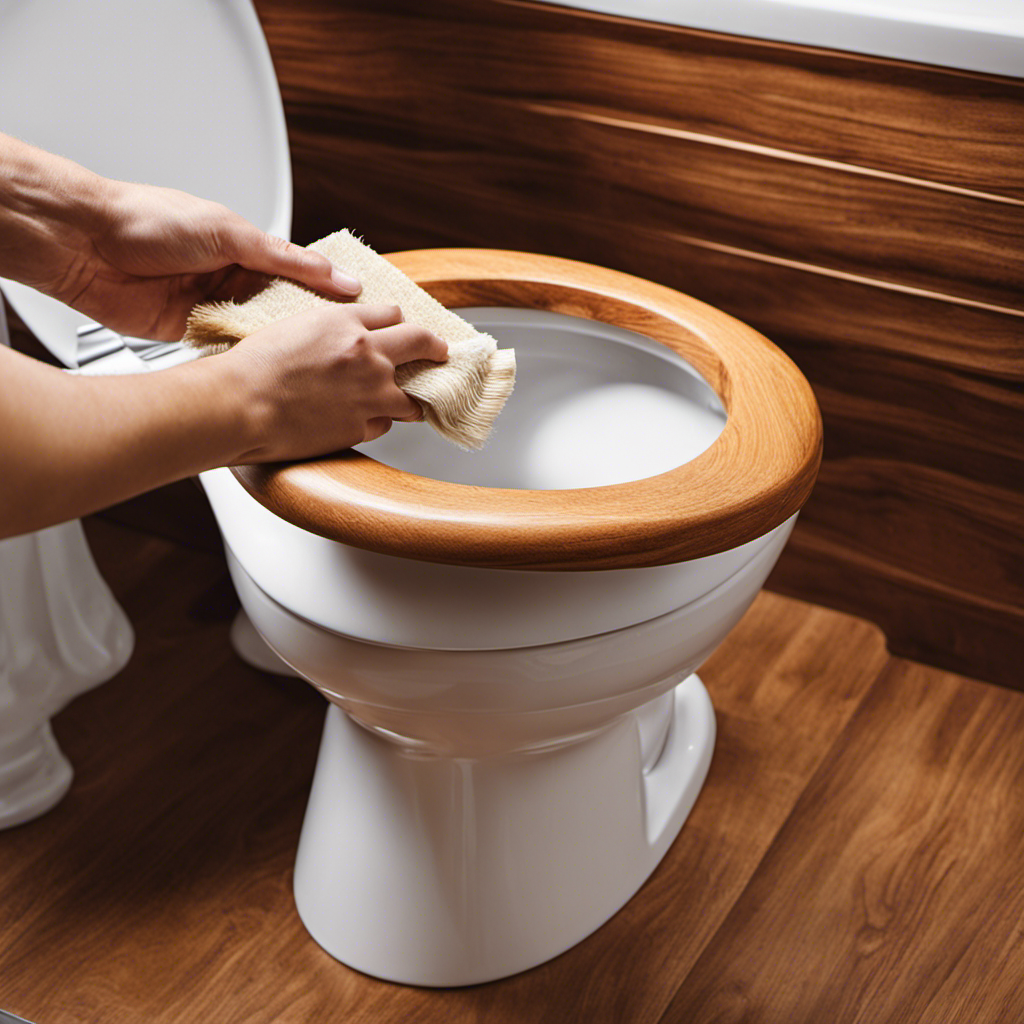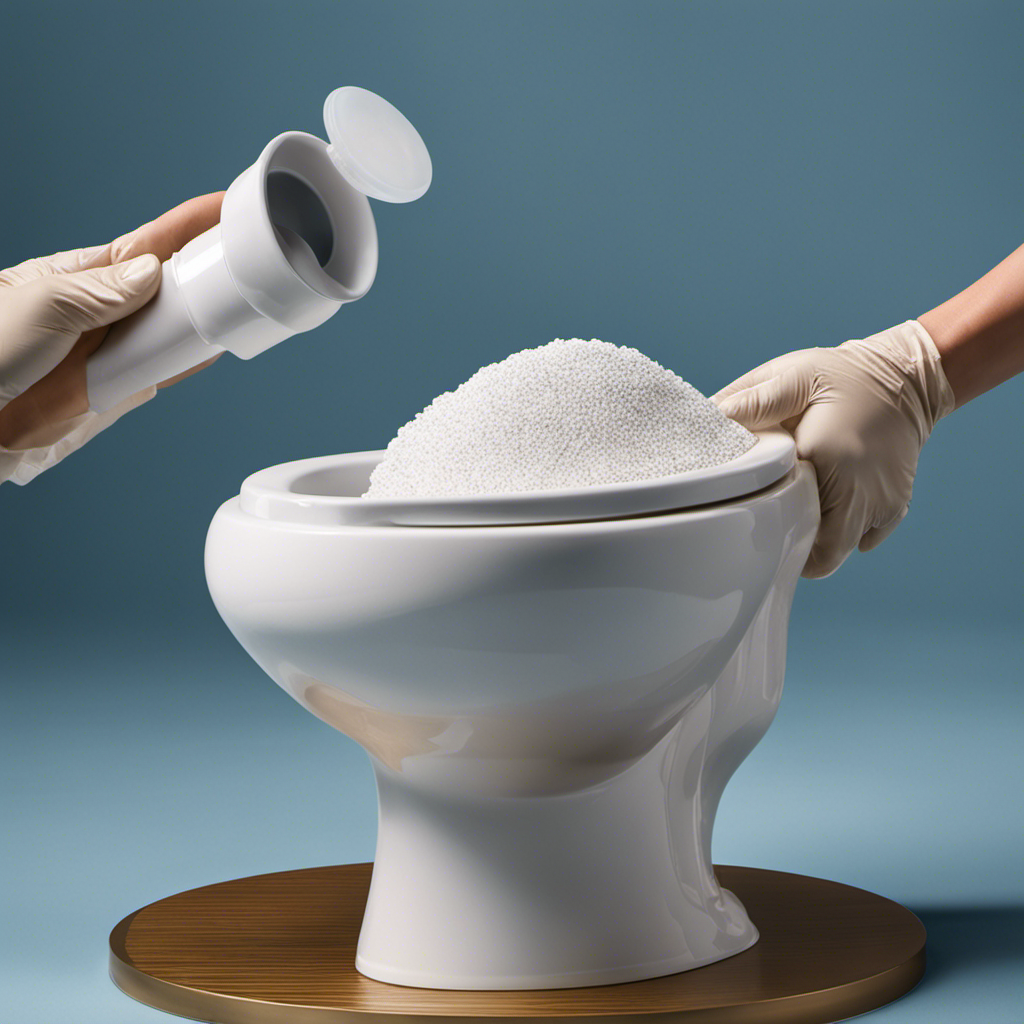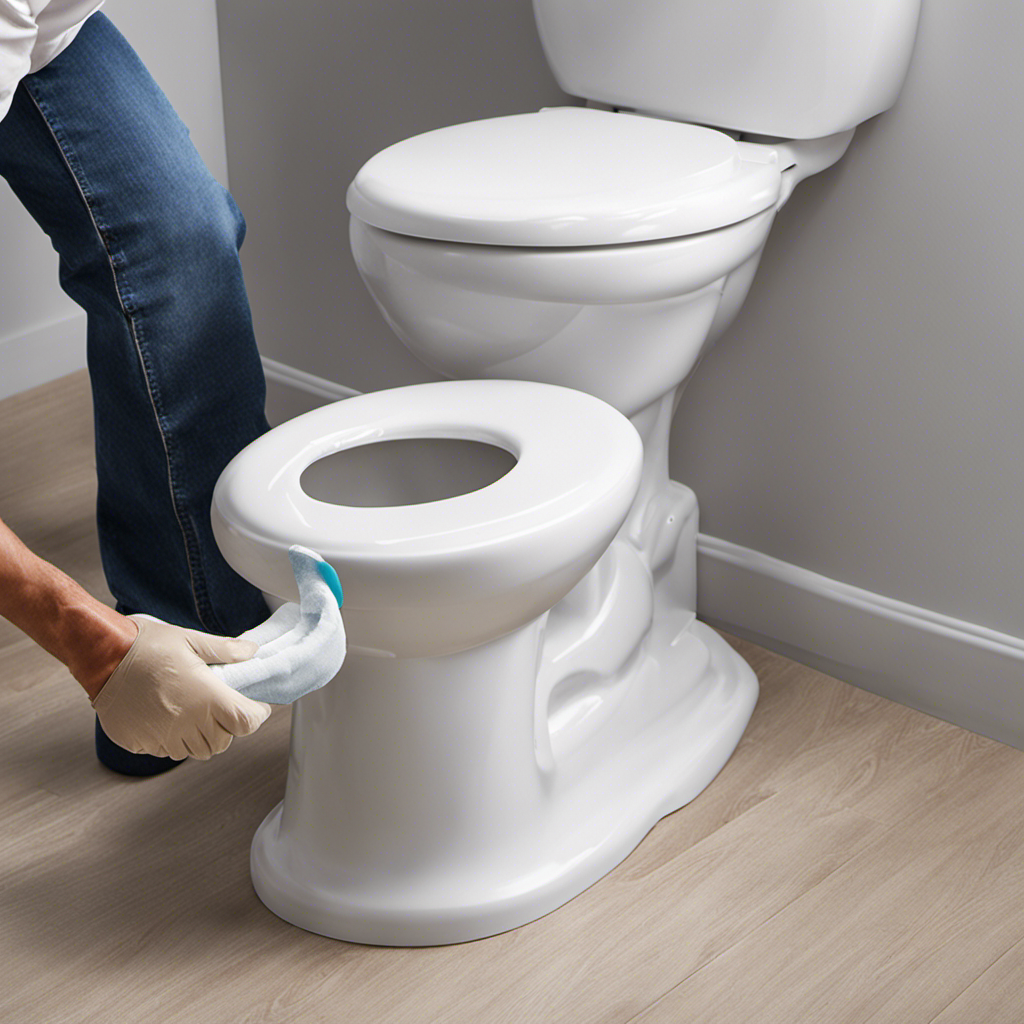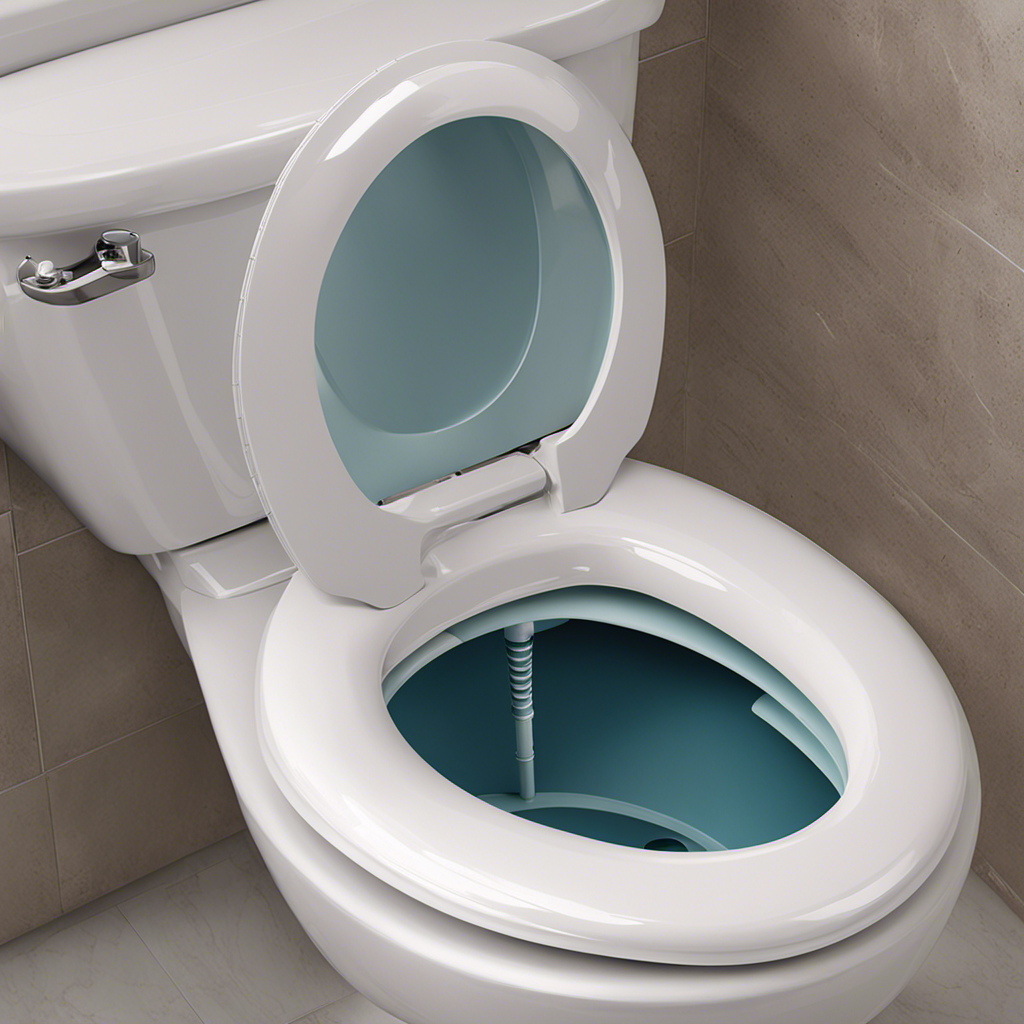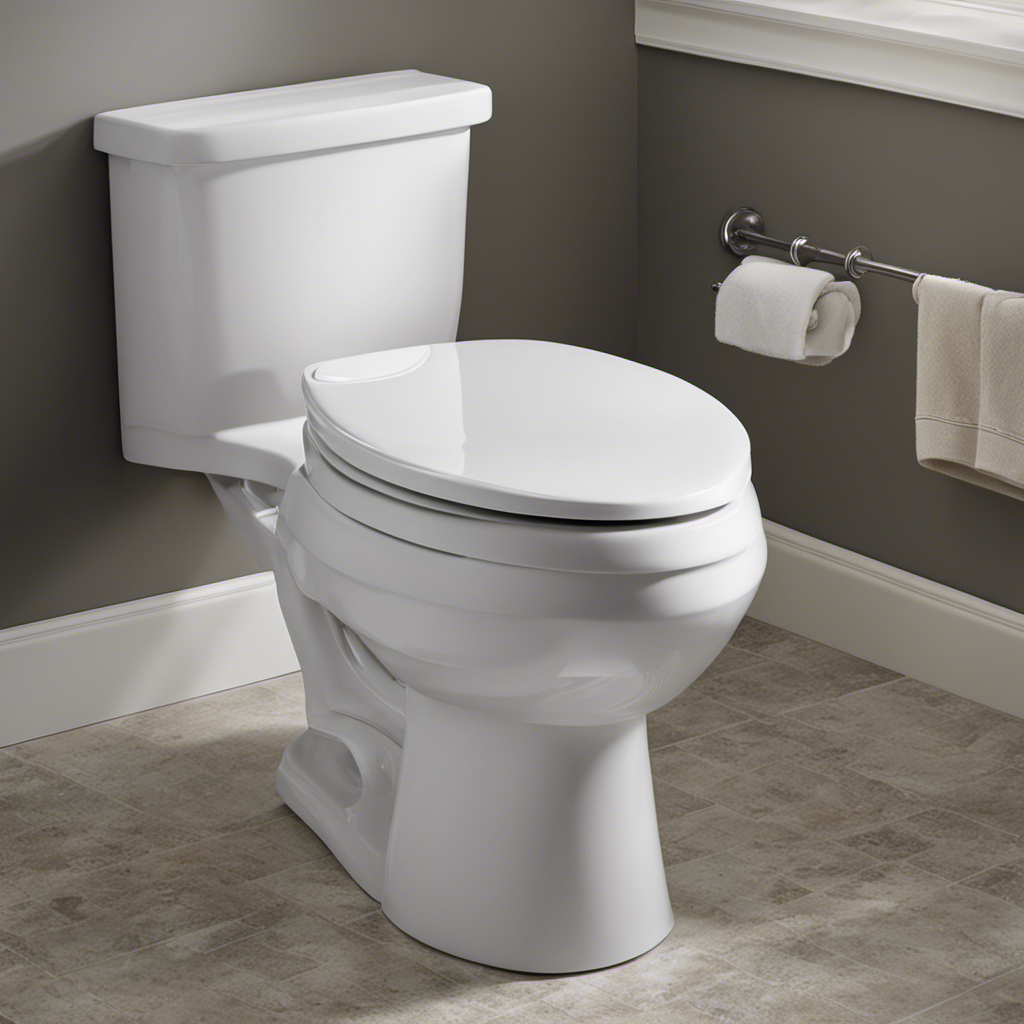I’ve spent countless hours searching for the perfect toilet seat, and when I finally found it – a beautiful wood toilet seat – I knew I had to keep it looking pristine.
With my trusty cleaning techniques, I’ve discovered the best way to maintain the natural beauty of a wood toilet seat.
In this article, I’ll walk you through the step-by-step process of cleaning and sanitizing your wood toilet seat, ensuring it stays fresh and inviting for years to come.
Key Takeaways
- Regular maintenance is essential to prevent damage and ensure cleanliness
- Harsh chemicals and abrasive cleaners should be avoided
- Natural cleaning solutions like vinegar, lemon juice, and baking soda are recommended
- Applying protective coatings like polyurethane or varnish can help maintain the wood toilet seat’s beauty and longevity
Understanding the Material: Wood Toilet Seat Cleaning Basics
Before cleaning a wood toilet seat, it’s important to understand the material and the basics of cleaning. Wood toilet seats require special care to maintain their beauty and longevity. Regular maintenance is essential to prevent damage and ensure a clean and hygienic surface.
When it comes to cleaning a wood toilet seat, it’s best to avoid harsh chemicals or abrasive cleaners as they can damage the wood. Instead, opt for natural cleaning solutions that are gentle yet effective. One option is to mix equal parts vinegar and water to create a mild cleaning solution. Another option is to use a mixture of baking soda and water to create a paste that can be applied to stains or dirt.
Always remember to wipe the wood toilet seat dry after cleaning to prevent moisture damage. With proper maintenance and the use of natural cleaning solutions, your wood toilet seat will remain in pristine condition for years to come.
Preparing the Cleaning Solution: Homemade Options for Wood Toilet Seat
To get started, you’ll want to mix together a homemade cleaning solution for your wooden toilet seat. As an experienced cleaner, I always prefer using natural cleaning alternatives. Not only are they effective, but they are also safe for both the environment and your health. Below, I’ve listed some of my favorite homemade cleaning recipes for wood toilet seats:
| Cleaning Solution | Ingredients | Instructions |
|---|---|---|
| Vinegar Solution | – 1 cup white vinegar – 1 cup water |
1. Mix vinegar and water in a spray bottle. 2. Spray the solution onto the toilet seat. 3. Let it sit for a few minutes. 4. Wipe clean with a microfiber cloth. |
| Lemon Juice Solution | – Juice of 2 lemons – 1 cup water |
1. Squeeze the lemons to extract the juice. 2. Mix lemon juice and water in a bowl. 3. Dip a cloth in the solution and wring out excess. 4. Wipe the toilet seat, focusing on stains or spots. 5. Rinse with clean water and dry thoroughly. |
These homemade cleaning solutions are not only effective but also gentle on your wooden toilet seat. Give them a try and see the difference for yourself!
Applying the Cleaning Solution: Step-by-Step Instructions
When it comes to cleaning, it’s important to prioritize safety and explore alternative methods.
In this discussion, I will delve into the topic of safe cleaning products and alternative cleaning methods.
With my extensive knowledge and experience, I will provide meticulous insights on how to maintain a clean and healthy environment while minimizing the use of harsh chemicals.
Safe Cleaning Products
You can use vinegar and water as a safe cleaning solution for your wood toilet seat. As someone who has tried various natural cleaning alternatives, I can confidently say that this method is both effective and eco-friendly.
Here are three reasons why vinegar and water should be your go-to cleaning option:
-
Gentle yet powerful: Vinegar is a natural acid that helps break down dirt and grime without damaging the wood surface. Its antibacterial properties also ensure a thorough clean.
-
Non-toxic and chemical-free: Unlike conventional cleaning products, vinegar and water contain no harsh chemicals or synthetic fragrances. This makes them safe for your health and the environment.
-
Cost-effective and readily available: Vinegar is a pantry staple that is affordable and easily accessible. By using this simple solution, you can save money while reducing your carbon footprint.
Alternative Cleaning Methods?
Using vinegar and water as a cleaning solution is not only effective for wood surfaces, but it can also be used to clean other household items.
When it comes to cleaning a wood toilet seat, it is important to find alternative methods that are safe and effective. One such method is steam cleaning. By using a steam cleaner, you can effectively remove dirt, grime, and bacteria from your wood toilet seat without causing any damage.
Additionally, you can create a vinegar solution by mixing equal parts vinegar and water. This solution can be used to wipe down the wood toilet seat, removing any stains or odors.
These alternative cleaning methods provide a thorough and safe approach to keeping your wood toilet seat clean and hygienic.
Now, let’s explore the proper techniques for scrubbing and sanitizing a wood toilet seat.
Scrubbing and Sanitizing: Proper Techniques to Clean Wood Toilet Seat
When it comes to cleaning a wood toilet seat, gentle cleaning methods are crucial to prevent damage.
As an experienced cleaner, I’ve found that using non-abrasive cleaning products and soft cloths or sponges is the best approach.
It’s also important to protect the wood by avoiding harsh chemicals or excessive scrubbing.
Gentle Cleaning Methods
To keep a wood toilet seat clean, it’s important to use gentle cleaning methods. As someone who has cared for many wood toilet seats over the years, I’ve learned a thing or two about eco-friendly cleaning options. Here are three tips to help you maintain the beauty and cleanliness of your wood toilet seat:
-
Use mild soap and warm water: Avoid harsh chemicals that can damage the wood. Instead, opt for a gentle soap and warm water solution to clean the seat. This will effectively remove any dirt or stains without causing any harm.
-
Vinegar and water solution: If you prefer a more natural approach, mix equal parts vinegar and water to create a cleaning solution. Vinegar acts as a disinfectant and helps to eliminate any bacteria or odors on the seat.
-
Regular dusting and wiping: Dusting the wood toilet seat regularly with a soft cloth or microfiber duster will prevent the accumulation of dirt and debris. Additionally, wiping the seat with a damp cloth after each use will ensure that it stays clean and hygienic.
By following these gentle cleaning methods, you can keep your wood toilet seat looking beautiful and sanitary.
Now let’s move on to the next important aspect of wood toilet seat care: protecting the wood.
Protecting the Wood
Now that we’ve discussed gentle cleaning methods for wood toilet seats, let’s move on to the next important aspect: protecting the wood.
Wood is a natural material that can be prone to damage if not properly cared for. One effective way to protect the wood is by applying protective coatings. These coatings provide a barrier that shields the wood from moisture, stains, and scratches.
There are various types of protective coatings available, such as polyurethane or varnish, which can be easily applied using a brush or a cloth. It’s important to choose a coating that is specifically designed for wood and follow the manufacturer’s instructions for application and drying times.
Additionally, it’s always a good idea to use natural cleaning methods, as harsh chemicals can strip away protective coatings and damage the wood over time.
Disinfecting Without Damage
One effective way to keep the wood protected is by using natural cleaning methods that won’t damage the surface. When it comes to disinfecting techniques for a wood toilet seat, it’s important to be careful and prevent any damage that harsh chemicals can cause.
Here are three safe and effective ways to disinfect your wood toilet seat without causing harm:
-
Vinegar and water solution: Mix equal parts of white vinegar and water in a spray bottle. Spray the solution onto the seat, let it sit for a few minutes, and then wipe it clean with a soft cloth.
-
Tea tree oil: Add a few drops of tea tree oil to a spray bottle filled with water. Spray the mixture onto the seat, let it sit for a few minutes, and then wipe it clean with a cloth.
-
Hydrogen peroxide: Mix hydrogen peroxide with water in a spray bottle. Spray the solution onto the seat, let it sit for a few minutes, and then wipe it clean.
By using these natural disinfecting techniques, you can effectively clean your wood toilet seat without causing any damage.
Now, let’s move on to the next step: drying and polishing to restore the shine of your wood toilet seat.
Drying and Polishing: Restoring the Shine of Your Wood Toilet Seat
Start by using a soft cloth and a wood-specific polish to restore the shine of your wood toilet seat. Gently wipe the surface of the seat with the cloth, making sure to remove any dirt or grime. Then, apply a small amount of the wood polish onto the cloth and buff the seat in circular motions. This will help to bring back the natural luster of the wood and give it a polished finish. It is important to regularly polish your wood toilet seat to prevent water damage. Moisture can seep into the wood and cause it to warp or crack over time. By keeping your seat well-polished, you can protect it from the damaging effects of water and maintain its beauty for years to come.
| Step 1 | Step 2 | Step 3 |
|---|---|---|
| Use a soft cloth | Apply wood polish | Buff in circular motions |
| Remove dirt and grime | Restore luster | Achieve polished finish |
| Prevent water damage | Protect from moisture | Maintain beauty |
Maintenance Tips: Keeping Your Wood Toilet Seat Clean and Fresh
To keep your wooden toilet seat looking and smelling fresh, regularly wipe it down with a mild cleaner. Here are three important maintenance tips to prevent stains and odors:
-
Avoid harsh chemicals: Harsh cleaners can damage the wood and strip away its protective finish. Stick to mild cleaners specifically designed for wood surfaces.
-
Dry thoroughly: After cleaning, make sure to dry your wood toilet seat thoroughly. Moisture can seep into the wood and cause warping or mold growth.
-
Apply a protective coating: To further protect your wood toilet seat, consider applying a thin layer of wood polish or sealant. This will help maintain its natural beauty and prevent stains from penetrating the surface.
Frequently Asked Questions
Can I Use Bleach to Clean My Wood Toilet Seat?
Yes, you can use bleach to clean your wood toilet seat, but it’s not recommended. Bleach alternatives, like vinegar or hydrogen peroxide, are gentler and safer for wood. The best cleaning products are ones specifically designed for wood surfaces.
How Often Should I Clean My Wood Toilet Seat?
I clean my wood toilet seat regularly to prevent stains and maintain its beauty. Following best practices is crucial for longevity. I’ve learned how to prevent stains and keep it looking pristine.
Can I Use Vinegar as a Cleaning Solution for My Wood Toilet Seat?
Yes, you can use vinegar as a cleaning solution for your wood toilet seat. Vinegar is a great natural cleaner with many benefits, such as being non-toxic and effective at removing stains and odors.
What Should I Do if There Are Stubborn Stains on My Wood Toilet Seat?
When stubborn stains appear on my wood toilet seat, I tackle them with a mixture of baking soda and water. For extra cleaning power, I use a soft cloth and gently scrub the stains away.
Is It Necessary to Polish My Wood Toilet Seat Regularly?
It’s important to regularly polish a wood toilet seat to maintain its beauty and protect it from damage. Using natural cleaning products offers benefits such as avoiding harsh chemicals and preserving the wood’s natural shine.
Conclusion
In conclusion, cleaning a wood toilet seat may seem like a daunting task, but with the right knowledge and techniques, it can be a breeze. By understanding the material and using homemade cleaning solutions, you can effectively remove dirt and grime from your toilet seat.
Remember to scrub and sanitize properly, and finish off by drying and polishing for that pristine shine. With regular maintenance, your wood toilet seat will always be clean and fresh, making your bathroom a true oasis.
Trust me, the results will be so spectacular, it’ll be like your toilet seat is sparkling with stardust.
